سبتمبر 2024
أخبار أمريكا الشمالية
أصدرت كندا إشعارًا محددًا بمركبات البوليفلوروكلوريل (PFAS). وفقًا للفقرة 71(1)(ب) من قانون حماية البيئة الكندي لعام 1999 (القانون)، بهدف تقييم السمية أو طرق السيطرة على المواد الموضحة، يجب على الأشخاص المعنيين تقديم معلومات محددة في موعد أقصاه 29 يناير 2025.
المحتويات الرئيسية هي:
1. من مطلوب منه الرد؟
ينطبق هذا الإشعار على أي شخص خلال السنة التقويمية 2023,
صنع كمية إجمالية تزيد عن 1000 جم من أي مادة مدرجة في الجدول 1.
استورد كمية إجمالية تزيد عن 10 جم من مادة مدرجة في الجزء 1 من الجدول 1، أو كمية إجمالية تزيد عن 100 كجم من مادة مدرجة في الجزء 2 أو الجزء 3 من الجدول 1.
استورد كمية إجمالية تزيد عن 100 كجم من أي مادة مدرجة في الجدول 1 بتركيز ≥ 1 جزء في المليون في مادة مصنعة غير مدرجة في فئات المواد المصنعة.
استخدم كمية إجمالية تزيد عن 10 جم من أي مادة مدرجة في الجدول 1، سواء كانت المادة بمفردها أو بتركيز ≥ 1 جزء في المليون في خليط أو في منتج، في تصنيع خليط أو منتج أو عنصر مصنع.
2. كيفية تحديد إذا كنت تستوفي معايير الإبلاغ (القسم 2 من الإشعار)
الإبلاغ بالطبقات (قسم الإشعار 3)
إذا كانت المنتجات التي تُصنعها تنتمي إلى إحدى الفئات وتجاوزت العتبات، يجب عليك تقديم جميع المعلومات المطلوبة من قبل الإشعار.
إذا لم تندرج العنصر المصنع الخاص بك تحت واحدة من الفئات وتم تجاوز الحدود ، فسيُطلب منك فقط تقديم معلومات شركتك وفقًا لقسم الإشعار 8 ، ووصف قصير واسم عام للعنصر المصنع الذي يحتوي على المادة وفقًا لقسم الإشعار 9.
الخلفاء أو المتنازل لهم (القسم 4 من الإشعار)
إذا تم بيع شركة خلال السنة التقويمية 2023، يمكن تقديم رد واحد يدمج المعلومات قبل وبعد النقل للعام الكامل.
الاستثناءات (القسمان 5 و6 من الإشعار)
يستبعد الإشعار:
الشركات الصغيرة التي لديها أقل من 5 موظفين أو تحقق أقل من 30,000 دولار في الإيرادات الإجمالية السنوية
يستبعد الإشعار أيضًا المواد والتركيبات والمنتجات والعناصر المصنعة التي:
فقط في العبور عبر كندا أو للاستخدام الشخصي
معد للاستخدام في مختبر للتحليل، في البحث العلمي
مصنفة على أنها نفايات خطرة أو مواد قابلة لإعادة التدوير الخطرة واستيرادها / تصديرها يتم وفقًا لـ لوائح حركة نقل النفايات الخطرة والمواد القابلة لإعادة التدوير الخطرة عبر الحدود.
مسجل تحت قانون مكافحة الآفات، قانون الأسمدة، قانون الأعلاف أو قانون البذور.
3. ما هي المعلومات المطلوبة (أقسام الإشعار من 7 إلى 14)
1. إذا قررت أنك تستوفي معايير الإبلاغ الخاصة بالإشعار، يجب عليك تقديم رد يحتوي على المعلومات المطلوبة، ملخصها أدناه:
معلومات التعريف (الشركة / المنظمة والشخص المُبلِغ)
معلومات المنشأة
كمية المادة المصنعة، المستوردة، المستخدمة في تصنيع منتج والمصدرة
معلومات عن المنتجات
2. يتم تقديم تفسيرات مفصلة، أمثلة، ونصائح لإكمال ردودك على الأقسام من 8-14 من الإشعار في المرفق أ.
3. من المهم ملاحظة أنه إذا كنت تمتلك أكثر من منشأة واحدة ، فيجب أن تأخذ في الاعتبار معايير الإبلاغ على نطاق الشركة بأكملها. يجب أن تجمع ردك على الإشعار المعلومات من جميع المنشآت المملوكة للشركة (قسم الإشعار 7).
معلومات إضافية مطلوبة: المعلومات المتاحة بشكل معقول؛ معلومات العمل السرية.
4.كيفية الرد على الإشعار
بمجرد أن تحدد ما إذا كنت تستوفي معايير الإبلاغ ، هناك ثلاث طرق للرد على الإشعار:
رد القسم 71 من CEPA
إذا كنت تستوفي معايير الإبلاغ، يجب عليك الرد على الإشعار عن طريق تقديم المعلومات المطلوبة في ملف تقرير Excel (ERF) لحكومة كندا.
قم بتنزيل ملف PFAS ERF من صفحة الاستجابة للإشعار الخاص بـ PFAS.
قم بإكمال المعلومات المطلوبة (التعليمات مضمنة في المرفق أ)
أرسل الملف ERF إلى الحكومة عبرنافذة واحدة للبيئة وتغيير المناخ في كندا (التعليمات مضمنة في المرفق ب)
إعلان اهتمام أصحاب المصلحة (SHI)
إذا كنت لا تستوفي متطلبات الإبلاغ، ولكنك مهتم بمادة يمكن الإبلاغ عنها، يمكنك تقديم SHI.
التالي هو قوائم جزئية لـ PFAS التي قد تتجاوز PFAS المدرجة في الإشعار:
قاعدة بيانات شاملة PFAS لـ OECD (الكيمياء المفلورة (oecd.org)),
الصفحة الرئيسية لوكالة حماية البيئة الأمريكية PFASSTRUCT (لوحة التحكم الكيميائية (epa.gov))، والشركة الأمريكية PFASDEV (لوحة التحكم الكيميائية (epa.gov)) (تشمل التعليمات في الملحق B).
إعلان عدم المشاركة (DNE)
إذا كنت لا تستوفي متطلبات الإبلاغ وليس لديك أي اهتمام بأي من المواد، فيُنصح بإرسال إعلان عدم المشاركة عن طريق إرسال بريد إلكتروني إلى substances@ec.gc.ca. قم بتحديد “PFAS DNE” في سطر موضوع البريد الإلكتروني وحدد اسم شركتك ومعلومات الاتصال الخاصة بها.
ملاحظة: يجب على الأشخاص المعنيين تقديم معلومات محددة في موعد أقصاه 29 يناير 2025. كما هو موضح في دليل الإرشادات، قد يؤدي عدم الرد إلى اتخاذ إجراءات إنفاذ بيئية وعقوبات محتملة للأفراد والشركات.
في الولايات المتحدة، عند تحديد المخاطر في منتجات المستهلكين، سيتم سحبها ونشرها في لجنة سلامة منتجات المستهلك (CPSC) استدعاءات حديثة على موقع CPSC، الذي يتم تحديثه يومياً. يتم تلخيص الاستدعاءات في الولايات المتحدة من 01 أغسطس 2024 إلى 31 أغسطس 2024 أدناه:
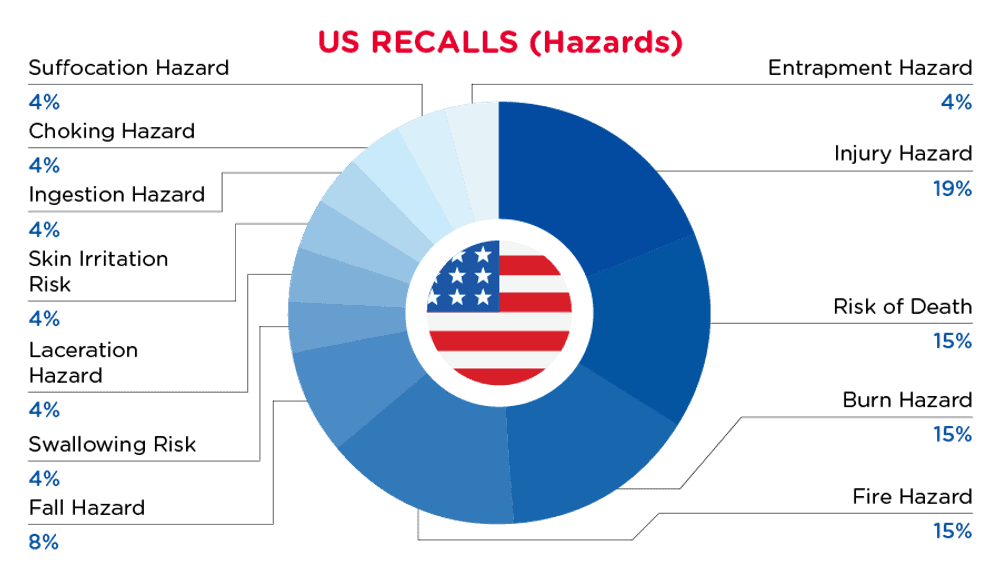
| المخاطر | التردد |
| خطر الإصابة | 4 |
| خطر الموت | 3 |
| خطر الحرق | 3 |
| خطر الحريق | 3 |
| خطر السقوط | 2 |
| مخاطر البلع | 1 |
| خطر التمزق | 1 |
| مخاطر تهيج الجلد | 1 |
| خطر الابتلاع | 1 |
| خطر الاختناق | 1 |
| خطر الاختناق | 1 |
| خطر الاحتجاز | 1 |

| فئات المنتجات | التردد |
| الألعاب ومنتجات رعاية الأطفال | 8 |
| الأجهزة الكهربائية | 3 |
| الأجهزة الكهربائية المنزلية | 3 |
| الأدوات المنزلية | 2 |
| السلع الرياضية / المعدات الرياضية | 2 |
| المواد الكيميائية | 1 |
| الأقمشة/ المنسوجات/ الملابس/ المنسوجات المنزلية | 1 |
| الماكينات | 1 |
| عناصر المعيشة في الهواء الطلق | 1 |
للحصول على قائمة كاملة انقر هنا
في كندا، عند تحديد المخاطر في منتجات المستهلك، سيتم سحبها ونشرها في قاعدة بيانات السحوبات والتحذيرات من المخاطر على موقع وزارة الصحة الكندية، والتي يتم تحديثها يومياً. يُلخص السحب في كندا من 01 أغسطس 2024 إلى 31 أغسطس 2024 فيما يلي:
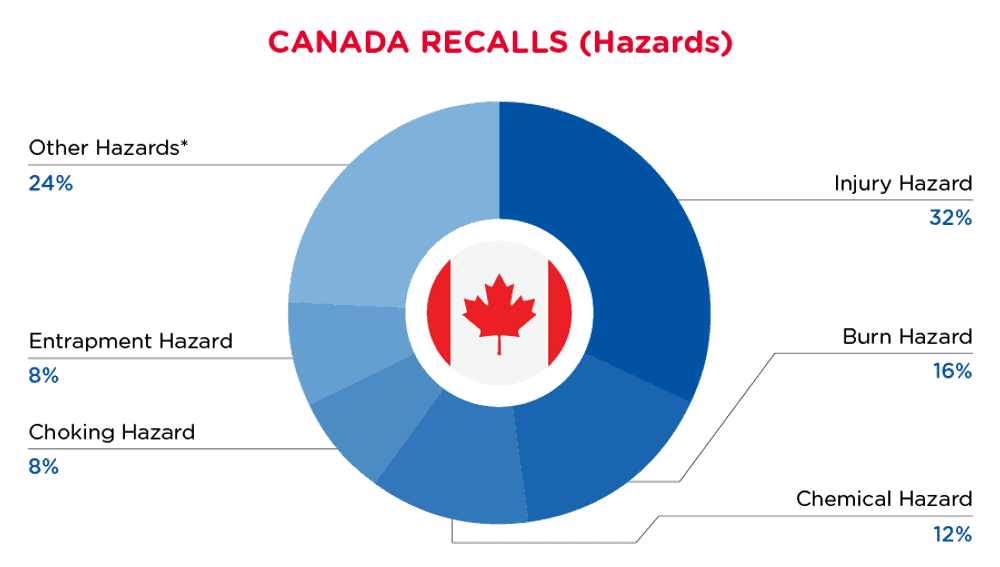
| المخاطر | التردد |
| خطر الإصابة | 8 |
| خطر الحرق | 4 |
| المخاطر الكيميائية | 3 |
| خطر الاختناق | 2 |
| خطر الاحتجاز | 2 |
| مخاطر أخرى* | 6 |
*تشمل المخاطر الأخرى الضرر بالبصر، الضرر بالجلد، خطر الحريق، خطر التمزق، خطر الموت وخطر الاختناق بتردد أقل من 2 مرة.

| فئات المنتجات | التردد |
| الألعاب ومنتجات رعاية الأطفال | 6 |
| الأقمشة/ المنسوجات/ الملابس/ المنسوجات المنزلية | 4 |
| العناية بالجسم/مستحضرات التجميل | 2 |
| إكسسوارات السيارات | 2 |
| المواد الكيميائية | 2 |
| الأجهزة الكهربائية | 1 |
| معدات الحماية | 1 |
| الأجهزة الكهربائية المنزلية | 1 |
| الماكينات | 1 |
للحصول على قائمة كاملة، انقر هنا
أخبار أوروبا
لقد أضافت المفوضية الأوروبية المدخل الجديد رقم 79 في الملحق السابع عشر للائحة (EC) رقم 1907/2006 التي تقيد استخدام PFHxA وأملاحها والمواد المرتبطة بـ PFHxA. سيتم حظر هذه المجموعات الفرعية من المواد البيرفلورية والبولي فلورية ألكيلية في المنسوجات الاستهلاكية وتغليف الأغذية ومستحضرات التجميل وما إلى ذلك. يجب على المصنعين الذين لديهم منتجات ذات صلة أن يهتموا بضمان الامتثال للمنتجات.
في 19 سبتمبر 2024، أصدرت المفوضية الأوروبية قيودًا تتعلق باستخدام حمض البيرفلوروهكسانويك (PFHxA) وأملاحه والمواد ذات الصلة بـPFHxA ، كخطوة هامة إلى الأمام في تقليل انبعاثات المواد البير والبوليفلورو ألكيلية (PFAS). غالبًا ما يُستخدم PFHxA كبديل لحمض البيرفلورواوكتانويك (PFOA)، وهو مادة أخرى محظورة من PFAS. أضيف هذا كإدخال رقم 79 في الملحق السابع عشر من اللائحة التنظيمية (EC) رقم 1907/2006 التي تركز على ضمان حماية صحة الإنسان والبيئة من خلال الترويج للاستخدام المسؤول للمواد الكيميائية، وتشجيع استبدال المواد الخطرة ببدائل أكثر أمانًا، وزيادة الشفافية حول خصائص واستخدامات المواد الكيميائية.
سيدخل حيز التنفيذ بعد فترات انتقالية تتراوح من 18 شهرًا إلى 5 سنوات، اعتمادًا على الاستخدام، مما يتيح الوقت لاستبداله ببدائل أكثر أمانًا. يجب على الشركات المصنعة للمنتجات ذات الصلة الاهتمام لضمان الامتثال للمنتجات.
امتلاك مجموعة بيرفلورو بنتلي خطية أو متفرعة بصيغة C5F11- متصلة مباشرة بذرة كربون أخرى كواحدة من العناصر الهيكلية؛ أو
امتلاك مجموعة بيرفلوروhexyl خطية أو متفرعة بصيغة C6F13-.
لا تشمل هذه التسمية المواد التالية:
C6F14.
C6F13-C(=O)OH, C6F13-C(=O)O-X′ أو C6F13-CF2-X′ (حيث X′ = أي مجموعة، بما في ذلك الأملاح)
أي مادة تحتوي على مجموعة بيرفلوروألكيل C6F13- متصلة مباشرة بذرة أكسجين عند واحدة من ذرات الكربون غير الطرفية.
1. مرجع للمواد ذات الصلة بـ PFHxA
المواد ذات الصلة بـ PFHxA هي مواد تُعتبر بناءً على تركيبها الجزيئي، أنها يمكن أن تتحلل أو تتحول إلى PFHxA. قائمة غير شاملة بالمواد التي تنتمي إلى نطاق الاقتراح التقييدي متاحة على موقع الوكالة الأوروبية للمواد الكيميائية.
2. جدول الانتقال التدريجي
| التنظيم | المنتجات/النطاق | المتطلبات | تاريخ السريان |
| EU REACH اللائحة التنظيمية (EC) رقم 1907/2006 الملحق السابع عشر إدخال 79 | - المنسوجات والجلود والفراء والجلود في الملابس والإكسسوارات ذات الصلة لعامة الناس. - الأحذية لعامة الناس. - الورق والكرتون المستخدم كمواد ملامسة للأغذية. - مستحضرات التجميل. - الخلائط لعامة الناس. | PFHxA وأملاحه: ≤ 25 ppb المواد ذات الصلة بـ PFHxA ≤ 1000 ppb | 10 أكتوبر 2026 |
| المنسوجات والجلود والفراء والجلود، بخلاف الملابس والاكسسوارات المتعلقة المشار إليها 1)، للجمهور العام. | 10 أكتوبر 2027 | ||
| رغاوي إطفاء الحرائق/ التركيزات للتدريب وللفحص، أو لخدمات الإطفاء العامة، إلا في الحالات التي تتدخل فيها تلك الخدمات في حالات الحرائق الصناعية في المؤسسات المشمولة بالتوجيه 2012/18/الاتحاد الأوروبي (المتعلق بمراقبة المخاطر الكبيرة المتعلقة بالمواد الخطرة) | ١٠ إبريل ٢٠٢٦ | ||
| رغاوي إطفاء الحرائق/ مركزات للطيران المدني (بما في ذلك في المطارات المدنية) | 10 أكتوبر 2029 |
لن تنطبق القيود على ما يلي:
معدات الحماية الشخصية ضمن نطاق اللائحة التنظيمية (EU) 2016/425 (تحدد متطلبات تصميم وتصنيع وتسويق معدات الحماية الشخصية (PPE)).
الأجهزة الطبية ضمن نطاق اللائحة التنظيمية (EU) 2017/745 (اللائحة الخاصة بالأجهزة الطبية).
الأجهزة الطبية التشخيصية in vitro ضمن نطاق اللائحة التنظيمية (EU) 2017/746 (تحدد معايير الأجهزة الطبية التشخيصية in vitro).
المواد التي تحتوي على مجموعة بيرفلوروألكيل C6F13- متصلة مباشرة بذرة كبريت محظورة في الملحق الأول لـ اللائحة التنظيمية (EU) 2019/1021 (POP) (تحمي صحة الإنسان والبيئة عن طريق تقييد أو حظر إنتاج واستخدام الملوثات العضوية المستمرة (POPs)).
سيكون من المهم للشركات المصنعة التركيز على تواريخ الفعالية لمنتجاتها الممثلة لضمان الامتثال.
قامت المديرية الأوروبية لجودة الأدوية والرعاية الصحية مؤخرًا بتحديث الدليل الفني للمعادن والسبائك الملامسة للأغذية إلى الطبعة الثانية لعام 2024. يمكن تطبيق هذا الدليل فورًا.
في 1 أغسطس 2024، قامت المديرية الأوروبية لجودة الأدوية والرعاية الصحية (EDQM) بتحديث الدليل الفني للمعادن والسبائك الملامسة للأغذية. بالمقارنة مع الطبعة الأولى السابقة، تمثل الطبعة الثانية المعدلة تحديثًا كبيرًا. التغييرات الرئيسية هي كما يلي:
1. نطاق الدليل المعدل:
تم إزالة وصف "المعادن والسبائك المستخدمة في مواد وأدوات تغليف الطعام والمغطاة بطبقة سطحية عضوية أثبتت قدرتها على الحد من إطلاق أيونات المعادن لتكون أقل من حد الإطلاق المحدد" من النطاق غير القابل للتطبيق.
هذا يعني أن جميع المعادن والسبائك المطلية يجب أن تتبع المتطلبات في هذا الدليل.
محدودية الإطلاق المحددة (SRL) المعدلة:
الجدول 1 - SRLs لمكونات المعادن والسبائك
| البند | العنصر | SRL في الدليل الثاني (ملغم/كغ طعام) | SRL في الدليل الأول (ملغم/كغ طعام) |
| 1 | الألومنيوم (Al) | 5 | 5 |
| 2 | الأنتيمون (Sb) | 0.04 | 0.04 |
| 3 | الكروم (Cr) | --- | 0.250 |
| 4 | الكروم (Cr) (III) | 1 | --- |
| 5 | الكوبالت (Co) | 0.02 | 0.02 |
| 6 | النحاس (Cu) | 4 | 4 |
| 7 | الحديد (Fe) | 40 | 40 |
| 8 | المغنيسيوم (Mg) | ---b | --- |
| 9 | المنغنيز (Mn) | 0.55 | 1.8 |
| 10 | الموليبدينوم (Mo) | 0.12 | 0.12 |
| 11 | النيكل (Ni) | 0.14 | 0.14 |
| 12 | الفضة (Ag) | 0.08 | 0.08 |
| 13 | القصدير (Sn) | 100a | 100 |
| 14 | التيتانيوم (Ti) | ---b | --- |
| 15 | الفاناديوم (V) | 0.01 | 0.01 |
| 16 | الزنك (Zn) | 5 | 5 |
| 17 | الزركونيوم (Zr) | 2 | --- |
a باستثناء في مجال التطبيق بموجب لائحة المفوضية (الاتحاد الأوروبي) 2023/915 بشأن المستويات القصوى لبعض الملوثات في الطعام.
b مستوى الإطلاق المحدد العام للمواد الغذائية بمقدار 60 ملغم/كغ غير قابل للتطبيق.
الجدول 2 - SRLs للمعادن كمُلوثات وشوائب
| البند | العنصر | SRL في الدليل الثاني (ملغم/كغ طعام) | SRL في الدليل الأول (ملغم/كغ طعام) |
| 1 | الزرنيخ (As) | 0.002 | 0.002 |
| 2 | الباريوم (Ba) | 1.2 | 1.2 |
| 3 | البيريليوم (Be) | 0.01 | 0.01 |
| 4 | الكادميوم (Cd) | 0.005 | 0.005 |
| 5 | الرصاص (Pb) | 0.010 | 0.010 |
| 6 | الليثيوم (Li) | 0.048 | 0.048 |
| 7 | الزئبق (Hg) | 0.003 | 0.003 |
| 8 | الثاليوم (Tl) | 0.001 | 0.0001 |
3. تحديث إعلان الامتثال (DoC):
أزالت الطبعة الثانية لعام 2024 الفصل الرابع السابق من جزء DoC.
إعلان المطابقة للمنتجات المنظمة في هذا الدليل يجب أن يتبع المتطلبات في القسم 8.2 من قرار CM/Res (2020)9 بشأن سلامة وجودة المواد والأدوات الملامسة للغذاء.
4. شروط الاختبار الأمثل:
تمت إضافة تعليمات للمواد/الأدوات الملامسة للأغذية الجافة:
إذا كانت الأداة مخصصة للملامسة فقط مع طعام جاف معين، يجب اختبارها مع ذلك الطعام.
تم تحديث شروط الاختبار لأنواع مختلفة من الهجرة:
إزالة شروط الاختبار المحددة للمقالات القابلة للتعبئة وغير القابلة للتعبئة؛ اتبع الشروط الفعلية للاستخدام أو طبق دليل مركز البحوث المشتركة للمفوضية الأوروبية (JRC) على شروط الاختبار للمقالات المتعلقة بأدوات المطبخ.
تم تغيير طريقة الاختبار لأجهزة المشروبات الساخنة:
يستبدل DIN 10531 بـ EN 16889:2016.
تم تطبيق عامل تخفيض قدره 5 على SR من الفضة لأدوات الأكل الفضية أو المطلية بالفضة في المنتجات التالية:
نوع الفئة FSI/CAH1* في دليل JRC، اختبار مع حمض الليمون كمحاكاة.
الأدوات المنظمة بواسطة EN ISO 8442-2، المواد والأدوات الملامسة للمواد الغذائية – أدوات الطعام وأدوات الأكل المجوفة.
الأدوات المصنفة بأنها ليست للاستخدام اليومي أو غير مناسبة للطهي وإعداد الطعام.
يمكن استخدام هذا الدليل التقني المعدل كمرجع فوري.
أعلنت الوكالة الأوروبية للمواد الكيميائية عن مرحلة تشاور لإدراج ست مواد كيميائية جديدة كمادة شديدة الخطورة (SVHC). في حال تمت الموافقة على هذه الإدراجات، سيتم تحديث عدد المواد المعترف بها كمادة شديدة الخطورة (SVHC) في قائمة المرشحين ليصل إلى 247 مادة.
في 30 أغسطس 2024، أطلقت الوكالة الأوروبية للمواد الكيميائية (ECHA) استشارة عامة لمدة 45 يوماً حول ست مواد جديدة محتملة قد تُضاف إلى قائمة المواد المثيرة للقلق الشديد (SVHC)، كما يظهر في الجدول أدناه.
إذا تمت الموافقة على هذا، سيتم تحديث عدد المواد المثيرة للقلق الشديد في قائمة المرشحين من 241 مادة إلى 247 مادة.
سيتم اتخاذ قرار بشأن إدراج المواد الموجودة أدناه في قائمة المرشحين للمواد المثيرة للقلق الشديد بعد الانتهاء من فترة التشاور التي تستمر لمدة 45 يوماً.
| اسم المادة (المواد) | رقم EC | رقم سجل دائرة المستخلصات الكيميائية | سبب الاقتراح |
| 6-[(C10-C13)-alkyl-(branched, unsaturated)-2,5-dioxopyrrolidin-1-yl]hexanoic acid | 701-118-1 | 2156592-54-8 | سامة للتكاثر (المادة 57 ج) |
| O,O,O-triphenyl phosphorothioate | 209-909-9 | 597-82-0 | PBT (المادة 57د) |
| Octamethyltrisiloxane | 203-497-4 | 107-51-7 | vPvvB (المادة 57e) |
| Perfluamine | 206-420-2 | 338-83-0 | vPvvB (المادة 57e) |
| مزيج تفاعلي من: triphenylthiophosphate ومشتقات phenyl المؤكسدة | 421-820-9 | 192268-65-8 | PBT (المادة 57د) |
| Tris(4-nonylphenyl, branched and linear) phosphite | / | / | خصائص تعطل الجهاز التناسلي (المادة 57(f) – البيئة) |
المعهد الألماني الفيدرالي لتقييم المخاطر (BfR) قام مؤخرًا بتحديث التوصيات لخمس أنواع من مواد التلامس الغذائي. يجب على مصنع الطلاءات المقاومة للحرارة المصنوعة من السيليكون/الورق أن يكون على دراية أنه قد تم مراجعة طرق الاختبار أو المتطلبات. يمكن تطبيق هذه الوثائق المحدثة فورًا.
في 1 أغسطس 2024، أصدر المعهد الألماني الفيدرالي لتقييم المخاطر (BfR) خمس توصيات محدثة تتعلق بمواد التلامس الغذائي. فيما يلي التوصيات المحدثة والمواد الغذائية المتأثرة:
| المرجع # | |
| XV | السيليكونات |
| XXXVI | ورق وكرتون لتلامس الغذاء |
| XXXVI/1 | أوراق الطهي، أوراق الترشيح الساخنة وطبقات الترشيح |
| XXXVI/2 | ورق وكرتون لأغراض الخبز |
| LI | أنظمة الطلاء البوليمرية المقاومة للحرارة لأدوات القلي والطهي والخبز |
التغييرات الرئيسية في المتطلبات وطرق الاختبار هي:
1. للسيليكونات XV:
حذف المتطلب للأجزاء القابلة للاستخراج (القسم الثالث، 5) التي لا تتجاوز 0.5%.
تحديث طريقة الاختبار للمادة العضوية المتطايرة (VOM):
الجدول 1
| البند | النسخة المحدثة في 1 أغسطس 2024 | النسخة السابقة |
| VOM | بعد التكييف، يتم اختبار العينة عند درجة حرارة 200 مئوية لمدة 4 ساعات. | بعد التكييف، يتم اختبار العينة عند درجة حرارة 200 مئوية لمدة 4 ساعات. |
| VOM | يمكن للمقالات التي لا تستطيع تحمل ظروف الاختبار المذكورة أعلاه، تطبيق الظروف البديلة في الجدول 3 من الملحق الخامس في اللوائح (الاتحاد الأوروبي) 10/2011. | بعد التكييف، يتم اختبار العينة عند درجة حرارة 200 مئوية لمدة 4 ساعات. |
2. لورق وكرتون التلامس الغذائي XXXVI:
تحديث متطلب الفثالات للورق المعاد تدويره:
الجدول 2
| تحديد الفثالات | النسخة المحدثة في 1 أغسطس 2024 | النسخة السابقة |
| DEHP | 0.6 ملغ/كغ | 1.5 ملغم/كغم |
| DBP | 0.12 ملغم/كغم | 0.3 ملغ/كغ |
| DIBP | 0.15 ملغ/كغ | 0.3 ملغ/كغ |
| مجموع (DBPx5 + DIBPx4 + DEHPx1) تقرير كـ DEHP | 0.6 ملغ/كغ | / |
3. لأوراق الطهي، الأوراق الساخنة للترشيح والبقية XXXVI/1 و XXXVI/2 لأغراض الخبز:
لا يوجد تحديث للمتطلبات أو طرق الاختبار.
بالمقارنة مع النسخة السابقة، تم تضمين أنواع من المضافات.
4. لأنظمة الطلاء البوليمري المقاومة للحرارة لأدوات القلي والطهي والخبز LI:
تمت إضافة متطلبات 10mg/dm2 للهجرة الكلية لاختبار الهجرة الثالث. شروط الاختبار كما يلي:
95% إيثانول، 60 ℃ لمدة 6 ساعات.
أيزو أوكتان، 60 ℃ لمدة 4 ساعات.
تحديث شروط الاختبار للهجرة الفرعية:
إزالة شروط الاختبار في النسخة السابقة.
تطبيق شروط الاختبار في دليل المركز المشترك للبحوث التابع للمفوضية الأوروبية (JRC) للمنتجات الغذائية تحت الفئات FPU/H2، FPU/H3، وتعديل الوقت لـ FPU/H4 إلى 4 ساعات.
تطبيق أكسيد البولي فينيلين المعدل (MPPO) كمادة تحاكي للمقالة المتلامسة مع الطعام الجاف؛ شرط الاختبار هو 175 درجة مئوية لمدة ساعتين (DIN EN 14338).
تطبيق النسخة الحالية من الدليل الفني للمركز الأوروبي للجودة للمواد والمعادن الطبية (EQDM) لاختبار الهجرة العنصرية.
ملاحظة: يمكن تطبيق هذه الوثائق المحدثة فورًا.
في أوروبا، عندما يتم تحديد المخاطر في المنتجات الاستهلاكية غير الغذائية، ستتم استعادة المنتجات ونشرها في نظام Safety Gate، والذي يتم تحديثه أسبوعياً. يتم تلخيص الاستدعاءات الأوروبية من 01 أغسطس 2024 إلى 31 أغسطس 2024 أدناه:
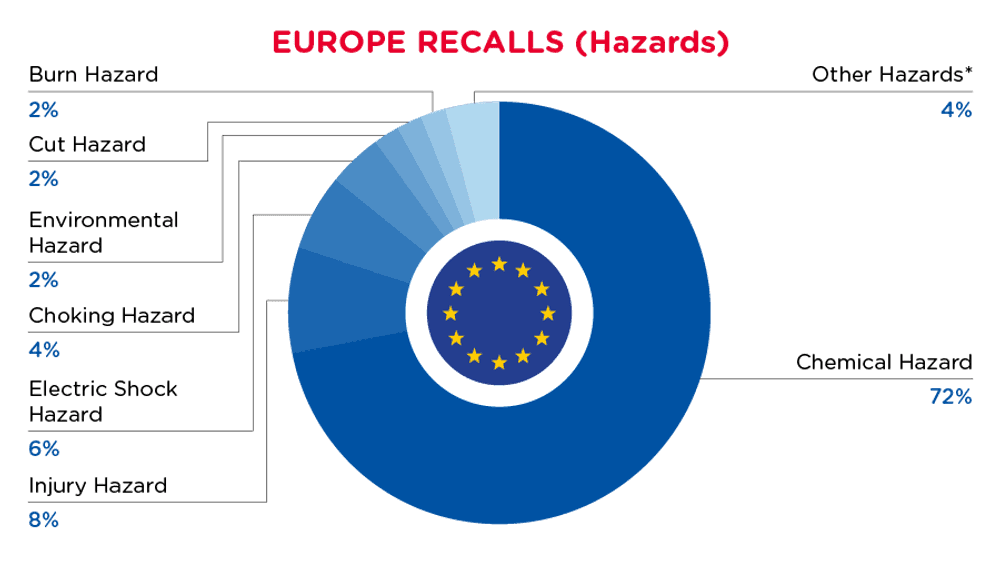
| المخاطر | التردد |
| المخاطر الكيميائية | 398 |
| خطر الإصابة | 42 |
| خطر الصدمة الكهربائية | 31 |
| خطر الاختناق | 21 |
| المخاطر البيئية | 13 |
| قطع الخطر | 12 |
| خطر الحرق | 12 |
| مخاطر أخرى* | 24 |
*تشمل المخاطر الأخرى خطر الاختناق، تلف البصر، خطر الغرق، خطر الحريق، خطر الاختناق، تلف السمع، خطر البيولوجيا الدقيقة وخطر الاحتجاز مع تكرار أقل من ٧.

| فئات المنتجات | التردد |
| العناية بالجسم/مستحضرات التجميل | 336 |
| الألعاب ومنتجات رعاية الأطفال | 50 |
| الأجهزة الكهربائية | 34 |
| المواد الكيميائية | 33 |
| الماكينات | 22 |
| الأقمشة/ المنسوجات/ الملابس/ المنسوجات المنزلية | 13 |
| فئات أخرى* | 35 |
*تشمل الفئات الأخرى الأجهزة الكهربائية المنزلية، المواد الخارجية، معدات الحماية، الألعاب / المعدات الرياضية، المجوهرات، الحاسوب / الصوت / الفيديو / إلكترونيات أخرى وإكسسواراتها، المواد المتلامسة مع الطعام، الأدوات والعتاد، الأثاث والأحذية مع تكرار أقل من ٨.
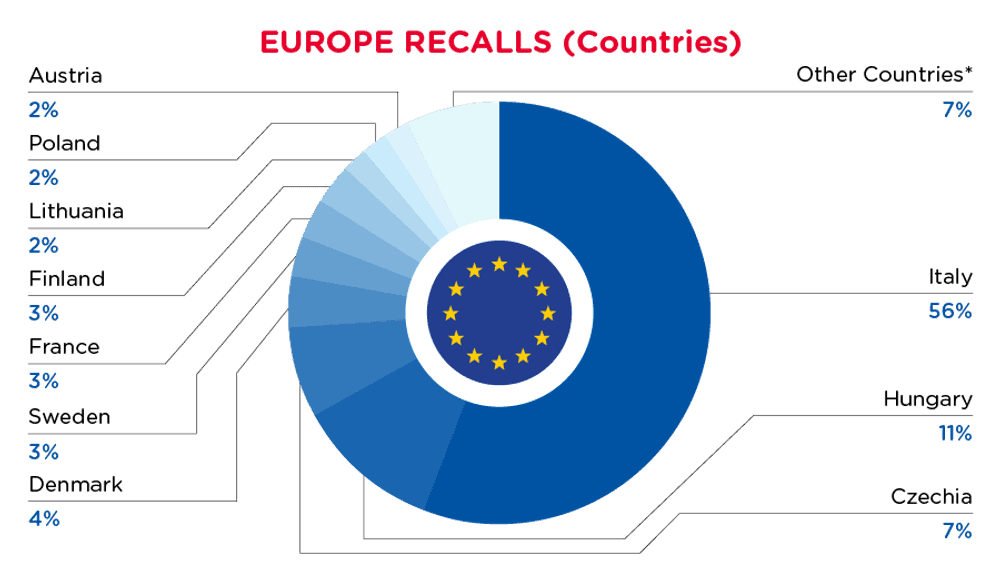
| إخطار الدولة | التردد |
| ايطاليا | 294 |
| هنغاريا | 55 |
| التشيك | 38 |
| الدنمارك | 20 |
| السويد | 15 |
| فرنسا | 14 |
| فنلندا | 14 |
| ليتوانيا | 13 |
| بولندا | 13 |
| النمسا | 10 |
| بلدان أخرى* | 37 |
*تشمل البلدان الأخرى ألمانيا، سلوفاكيا، رومانيا، قبرص، النرويج، أيرلندا، هولندا، بلغاريا، بلجيكا ولاتفيا مع تكرار أقل من ١٠.
لقائمة كاملة انقر هنا
أخبار الصين
في الصين، عندما يتم تحديد المخاطر في منتجات المستهلكين، سيتم استدعاؤها ونشرها في مركز إدارة المنتجات العيبية SAMR، الذي يُحدث يوميًا. يتم تلخيص الاستدعاءات في الصين من 01 أغسطس 2024 إلى 31 أغسطس 2024 على النحو التالي:
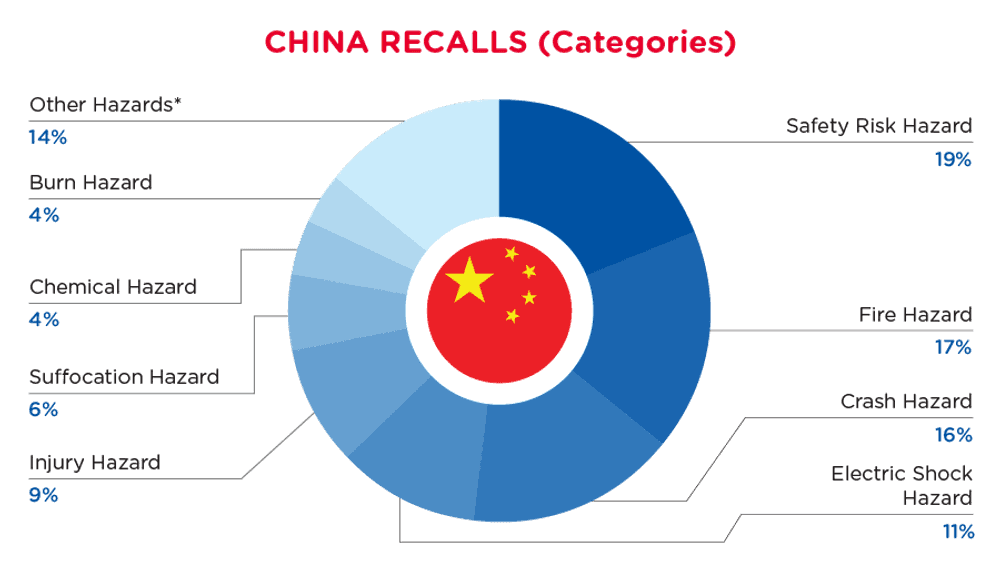
| المخاطر | التردد |
| مخاطر مخاطر السلامة | 25 |
| خطر الحريق | 23 |
| خطر التصادم | 21 |
| خطر الصدمة الكهربائية | 15 |
| خطر الإصابة | 12 |
| خطر الاختناق | 8 |
| المخاطر الكيميائية | 6 |
| خطر الحرق | 5 |
| مخاطر أخرى* | 19 |
*المخاطر الأخرى تشمل مخاطر الانفجار، وخطر الابتلاع، ومخاطر السقوط، والضرر بالبصر، والضرر بالسمع، ومخاطر الثقب، ومخاطر التشابك، ومخاطر الصحة ومخاطر التمزق بتردد أقل من 4.

| فئات المنتجات | التردد |
| السلع الرياضية / المعدات الرياضية | 44 |
| الألعاب ومنتجات رعاية الأطفال | 21 |
| الأجهزة الكهربائية المنزلية | 6 |
| الأجهزة الكهربائية | 5 |
| القرطاسية | 3 |
| فئات أخرى* | 7 |
*الفئات الأخرى تشمل مواد التواصل مع الطعام، والحواسيب / الصوت / الفيديو / الإلكترونيات والإكسسوارات الأخرى، والأدوات المنزلية، والأقمشة / الملابس / الملابس المنزلية، ومعدات الحماية والأدوات والأجهزة بتردد أقل من 3.

| المقاطعات | التردد |
| قوانغدونغ | 28 |
| تشجيانغ | 21 |
| تيانجين | 9 |
| شنغهاي | 8 |
| خنان | 6 |
| هونان | 5 |
| مقاطعات أخرى* | 9 |
*المقاطعات الأخرى تشمل منغوليا الداخلية، وفوجيان، وجيانغسو، وسيشوان، ولياونينغ، وشانشي بتردد أقل من 2.
للحصول على قائمة كاملة انقر هنا
أخبار أستراليا/نيوزيلندا
في أستراليا، عند تحديد المخاطر في منتجات المستهلك، سيتم سحبها ونشرها في قاعدة بيانات سحب وتنبيهات السلامة على موقع الهيئة الأسترالية للمنافسة وحماية المستهلك، والذي يُحدَّث يوميًا. ويتم تلخيص سحوبات أستراليا من 01 أغسطس 2024 حتى 31 أغسطس 2024 كما هو موضح أدناه:
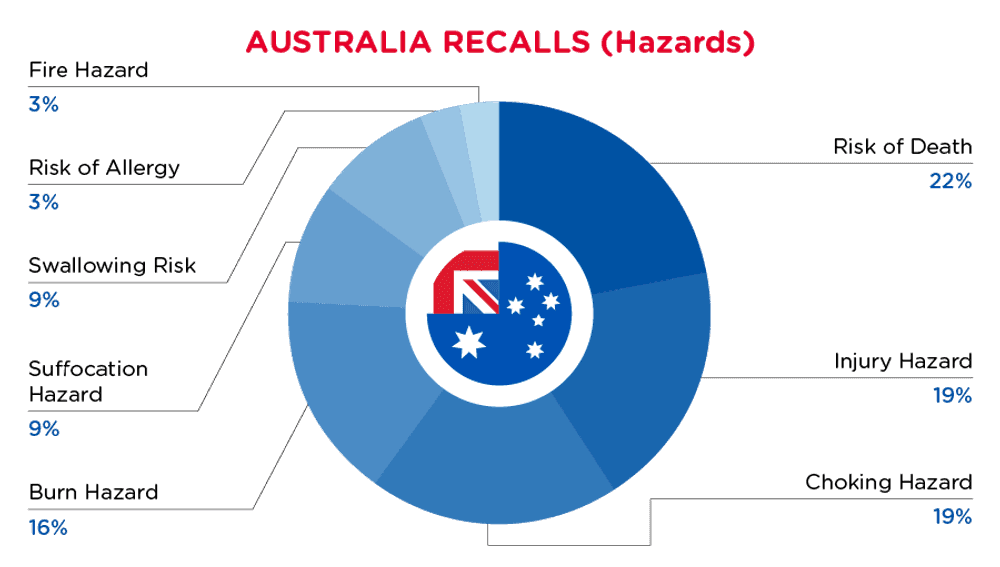
| المخاطر | التردد |
| خطر الموت | 7 |
| خطر الإصابة | 6 |
| خطر الاختناق | 6 |
| خطر الحرق | 5 |
| خطر الاختناق | 3 |
| مخاطر البلع | 3 |
| خطر الإصابة بالحساسية | 1 |
| خطر الحريق | 1 |

| فئات المنتجات | التردد |
| الأقمشة/ المنسوجات/ الملابس/ المنسوجات المنزلية | 5 |
| الألعاب ومنتجات رعاية الأطفال | 2 |
| الأجهزة الكهربائية | 2 |
| السلع الرياضية / المعدات الرياضية | 2 |
| العناية بالجسم/مستحضرات التجميل | 1 |
| الأدوات المنزلية | 1 |
للحصول على قائمة كاملة انقر هنا
الأخبار الفيدرالية الأمريكية
في 5 سبتمبر 2024، أصدرت وكالة حماية البيئة الأمريكية (EPA) قانون نهائي مباشر الذي سيؤجل بدء فترة تقديم بيانات PFAS حتى 11 يوليو 2025. لا توجد تغييرات أخرى على متطلبات الإبلاغ وحفظ السجلات في القاعدة الحالية تحت TSCA (40 CFR الجزء 705).
أصدرت وكالة حماية البيئة الأمريكية (EPA) قانونًا نهائيًا مباشرًا في 5 سبتمبر 2024 والذي سيؤجل تاريخ بدء تقديم بيانات المواد المشبعة والمواد الفلورية المستخدمة في الصناعة (PFAS) للإبلاغ وحفظ السجلات المطلوبة بموجب قانون المواد السامة (TSCA). يؤجل هذا التأخير تاريخ البدء من 12 نوفمبر 2024 إلى 11 يوليو 2025. لم يتم تنفيذ أي تغييرات أخرى على متطلبات الإبلاغ وحفظ السجلات في القاعدة الحالية بموجب TSCA (40 CFR الجزء 705).
خلفية عن متطلبات الإبلاغ وحفظ السجلات بموجب القسم 8(a)(7) من TSCA لبيانات PFAS
كما تم نشرها في أكتوبر 2023، تتطلب القاعدة من المصنعين (بما في ذلك المستوردين) للمواد PFAS في أي سنة بين 2011-2022 تقديم بيانات معينة إلى وكالة حماية البيئة تتعلق بالتعرض والتأثيرات البيئية والصحية.
نظرًا للمشاكل العامة المتعلقة بالميزانية وقيود الموارد، خفض مقاولو وكالة حماية البيئة (EPA) جهدهم على برنامج تكنولوجيا المعلومات المتعلق بقانون مراقبة المواد السامة (TSCA) والمحفظة ذات الصلة بأكثر من 50 بالمائة، مما كان له انعكاسات كبيرة وفورية على قدرة وكالة حماية البيئة على تحقيق تقدم في العديد من مشاريع تكنولوجيا المعلومات / إدارة المعلومات (IT/IM).
لضمان قدرات الإبلاغ الوظيفية، يجب على وكالة حماية البيئة تمديد الجدول الزمني لمشروع التطوير. وبالتالي، تم تغيير بداية فترة تقديم البيانات من 12 نوفمبر 2024 إلى 11 يوليو 2025. سيُطلب من معظم المبلغين عن هذه البيانات إكمال جميع الإبلاغات بحلول 22 يناير 2026. سيكون لدى الشركات الصغيرة التي تقدم بيانات فقط عن استيراد PFAS الموجودة في المقالات حتى 11 يوليو 2026 لتقديم التقارير.
التأثير على الكيانات المنظمة
لدى المبادرات الاستراتيجية المحيطة بـ PFAS تحت تنظيم TSCA تأثير كبير على المصنعين والمستوردين. يجب على الكيانات المنظمة النظر ليس فقط في مدى تضمن عملياتهم منتجات تحتوي على PFAS، ولكن أيضًا في ما إذا كانت المنتجات ضمن سلسلة التوريد الخاصة بهم قد تحتوي على PFAS. يسمح بدء الإبلاغ المتأخر للكيانات ذات الصلة بأن تكون مستعدة جيدًا لهذا الالتزام بالإبلاغ القوي.
يجدر بالذكر أنه، بالرغم من أن مشاكل الميزانية والموارد أدت إلى تأخير في متطلبات جمع البيانات، فإن النافذة لإجراء مثل هذا الجمع الكبير للبيانات وتجميع التقارير الإلزامية تُغلق بسرعة. وهذا يُظهر التزام وكالة حماية البيئة بالمضي قدمًا في هذا الإبلاغ، كما اقترح في البداية.
اشترك في نشرتنا حول تحديثات القوانين واللوائح
قم بإلغاء الاشتراك في أي وقت. اقرأ سياسة الخصوصية الخاصة بنا.